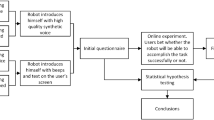Abstract
Automatic Speech Recognition (ASR) is a complex task, which depends on language, vocabulary and context. In the navigation control of mobile robots, the set of possible interpretations for a command utterance may be reduced in favor of the recognition rate increase, if we consider that the robot’s work environment is quite defined and with constant elements. In this paper we propose a contextual model in addition to the acoustic and language models used by mainstream ASRs. We provide a whole mobile robot navigation system which use contextual information to improve the recognition rate of speech-based commands. Recognition accuracy has been evaluated by Word Information Lost (WIL) metric. Results show that the insertion of a contextual model provides a improvement around 3% on WIL.
Access this chapter
Tax calculation will be finalised at checkout
Purchases are for personal use only
Preview
Unable to display preview. Download preview PDF.
Similar content being viewed by others
References
Atrash, A., Kaplow, R., Villemure, J., West, R., Yamani, H., Pineau, J.: Development and validation of a robust speech interface for improved human-robot interaction. Int. J. of Social Robotics 1, 345–356 (2009)
Chang, M., Chou, J.: A friendly and intelligent human-robot interface system based on human face and hand gesture. In: IEEE/ASME Int. Conf. on Advanced Intelligent Mechatronics, pp.1856–1861 (2009)
Good, I.J.: The Population Frequencies of Species and the Estimation of Population Parameters. Biometrika 40, 237–264 (1953)
Green, P., Maier, V., Morris, A.C.: From WER and RIL to MER and WIL: Improved Evaluation Measures for Connected speech Recognition. In: Proc. of 8th Int. Conf. on Spoken Language Processing INTERSPEECH 2004, ICSLP, Jeju, KR, pp. 2765–2768 (2004)
Heyer, C.: Human-robot interaction and future industrial robotics applications. In: 2010 IEEE Int. Conf. on Int. Robots and Systems (IROS), pp. 4749–4754 (2010)
Maas, J., Spexard, T., Fritsch, J., Wrede, B., Sagerer, G.: BIRON, what’s the topic? A Multi-Modal Topic Tracker for improved Human-Robot Interaction. In: The 15th IEEE Int. Symp. on Robot and Human Interactive Commu., pp. 26–32 (2006)
Moratz, R., Fischer, K., Tenbrink, T.: Cognitive modeling of spatial reference for human-robot interaction. Int. J. Art. Int. Tools 10(4), 589–611 (2001)
Müller, R., Röfer, T., Lankenau, A., Musto, A., Stein, K., Eisenkolb, A.: Coarse Qualitative Descriptions in Robot Navigation. In: Habel, C., Brauer, W., Freksa, C., Wender, K.F. (eds.) Spatial Cognition 2000. LNCS (LNAI), vol. 1849, pp. 265–276. Springer, Heidelberg (2000)
Neto, N., Patrick, C., Klautau, A., Trancoso, I.: Free tools and resources for Brazilian Portuguese speech recognition. J. of the Brazilian Comp. Society 17(1), 53–68 (2011)
Ross, R., O’Donoghue, R., O’Hare, G.: Improving Speech Recognition on a Mobile Robot Platform through the use of Top-Down Visual Queues. In: Proc. of the 18th Int. Joint Conf. on Artificial Intelligence, IJCAI 2003, pp. 1557–1559 (2003)
Santos, D., Bick, E.: Providing Internet access to Portuguese corpora: the AC/DC project. In: Proc. of the Second Int. Conf. on Language Resources and Evaluation (LREC 2000), pp. 205–210 (2000)
Sun, H., Yang, P., Liu, Z., Zu, L., Xu, Q.: Microphone array based auditory localization for rescue robot. In: 2011 Chinese Control and Decision Conference (CCDC), pp. 606–609 (2011)
Wang, B., Li, Z., Ding, N.: Speech control of a teleoperated mobile humanoid robot. In: 2011 IEEE Int. Conf. on Automation and Logistics (ICAL), pp. 339–344 (2011)
Author information
Authors and Affiliations
Editor information
Editors and Affiliations
Rights and permissions
Copyright information
© 2012 Springer-Verlag Berlin Heidelberg
About this paper
Cite this paper
Araújo, G.F., Macedo, H.T. (2012). Context-Sensitive ASR for Controlling the Navigation of Mobile Robots. In: Barros, L.N., Finger, M., Pozo, A.T., Gimenénez-Lugo, G.A., Castilho, M. (eds) Advances in Artificial Intelligence - SBIA 2012. SBIA 2012. Lecture Notes in Computer Science(), vol 7589. Springer, Berlin, Heidelberg. https://doi.org/10.1007/978-3-642-34459-6_20
Download citation
DOI: https://doi.org/10.1007/978-3-642-34459-6_20
Publisher Name: Springer, Berlin, Heidelberg
Print ISBN: 978-3-642-34458-9
Online ISBN: 978-3-642-34459-6
eBook Packages: Computer ScienceComputer Science (R0)




